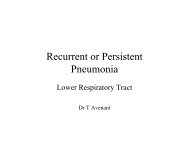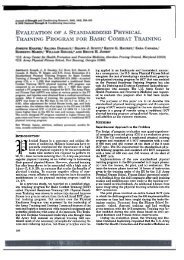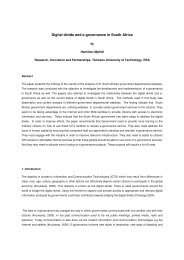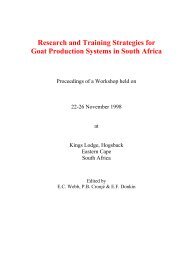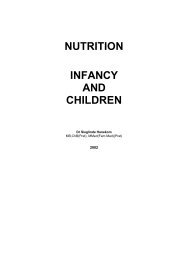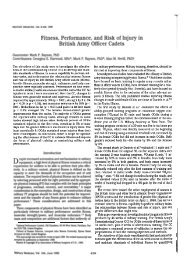An introduction to power and sample size estimation
An introduction to power and sample size estimation
An introduction to power and sample size estimation
You also want an ePaper? Increase the reach of your titles
YUMPU automatically turns print PDFs into web optimized ePapers that Google loves.
454 Jones, Carley, Harrison<br />
The term <strong>power</strong> is commonly used with reference <strong>to</strong> all<br />
<strong>sample</strong> <strong>size</strong> <strong>estimation</strong>s in research. Strictly speaking “<strong>power</strong>”<br />
refers <strong>to</strong> the number of patients required <strong>to</strong> avoid a type ΙΙ<br />
error in a comparative study. Sample <strong>size</strong> <strong>estimation</strong> is a more<br />
encompassing term that looks at more than just the type ΙΙ<br />
error <strong>and</strong> is applicable <strong>to</strong> all types of studies. In common parlance<br />
the terms are used interchangeably.<br />
WHAT AFFECTS THE POWER OF A STUDY?<br />
There are several fac<strong>to</strong>rs that can affect the <strong>power</strong> of a study.<br />
These should be considered early on in the development of a<br />
study. Some of the fac<strong>to</strong>rs we have control over, others we do<br />
not.<br />
The precision <strong>and</strong> variance of measurements within<br />
any <strong>sample</strong><br />
Why might a study not find a difference if there truly is one?<br />
For any given result from a <strong>sample</strong> of patients we can only<br />
determine a probability distribution around that value that<br />
will suggest where the true population value lies. The best<br />
known example of this would be 95% confidence intervals.<br />
The <strong>size</strong> of the confidence interval is inversely proportional <strong>to</strong><br />
the number of subjects studied. So the more people we study<br />
the more precise we can be about where the true population<br />
value lies.<br />
Figure 1 shows that for a single measurement, the more<br />
subjects studied the narrower the probability distribution<br />
www.emjonline.com<br />
Downloaded from<br />
emj.bmjjournals.com on 28 July 2005<br />
Figure 1 Change in confidence<br />
interval width with increasing<br />
numbers of subjects.<br />
becomes. In group 1 the mean is 5 with wide confidence intervals<br />
(3–7). By doubling the number of patients studied (but in<br />
our example keeping the values the same) the confidence<br />
intervals have narrowed (3.5–6.5) giving a more precise<br />
estimate of the true population mean.<br />
The probability distribution of where the true value lies is<br />
an integral part of most statistical tests for comparisons<br />
between groups (for example, t tests). A study with a small<br />
<strong>sample</strong> <strong>size</strong> will have large confidence intervals <strong>and</strong> will only<br />
show up as statistically abnormal if there is a large difference<br />
between the two groups. Figure 2 demonstrates how increasing<br />
the number of subjects can give a more precise estimate of<br />
differences.<br />
The magnitude of a clinically significant difference<br />
If we are trying <strong>to</strong> detect very small differences between treatments,<br />
very precise estimates of the true population value are<br />
required. This is because we need <strong>to</strong> find the true population<br />
value very precisely for each treatment group. Conversely, if we<br />
find, or are looking for, a large difference a fairly wide<br />
probability distribution may be acceptable.<br />
In other words if we are looking for a big difference between<br />
treatments we might be able <strong>to</strong> accept a wide probability distribution,<br />
if we want <strong>to</strong> detect a small difference we will need<br />
great precision <strong>and</strong> small probability distributions. As the<br />
width of probability distributions is largely determined by<br />
how many subjects we study it is clear that the difference<br />
sought affects <strong>sample</strong> <strong>size</strong> calculations.<br />
Figure 2 Effect of confidence<br />
interval reduction <strong>to</strong> demonstrate a<br />
true difference in means. This<br />
example shows that the initial<br />
comparison between groups 1 <strong>and</strong> 3<br />
showed no statistical difference as the<br />
confidence intervals overlapped. In<br />
groups 3 <strong>and</strong> 4 the number of<br />
patients is doubled (although the<br />
mean remains the same). We see that<br />
the confidence intervals no longer<br />
overlap indicating that the difference<br />
in means is unlikely <strong>to</strong> have occurred<br />
by chance.








